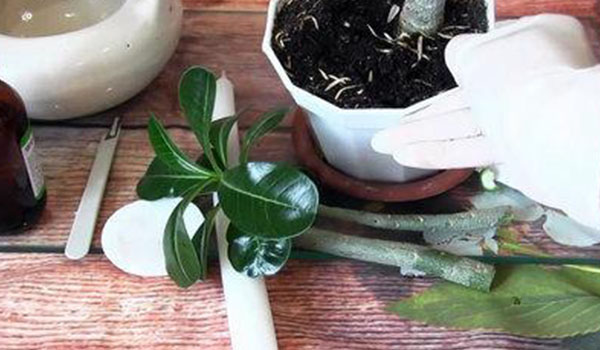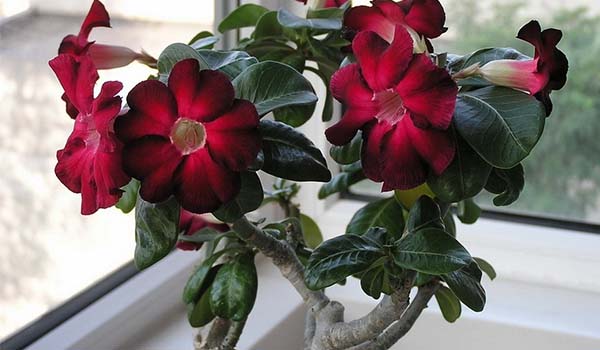What size does Obesum reach at home?
The peculiarity of Adenium is caudex, in other words - a thickening at the base of the trunk, which gives it an unusual flavor. A young plant resembles a bottle in its appearance, but over the years its roots thicken significantly, and rapidly grow over the entire surface, creating an original look. At home, the tree grows no more than a meter in height and up to 70 cm in width.
Attention! Adenium contains toxic substances, in a house where there are small children or pets, it is not recommended to keep such exotic things.
Adenium, not spoiled by natural conditions, adapts well in the house and allows you to do various experiments on yourself. Some growers give it a bizarre shape, in the form of abstract sculptures, green octopuses.
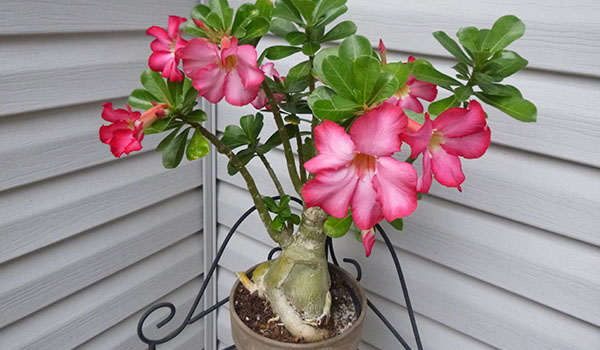
Peculiarities
The tree-like succulent of the Kutrovy family is considered one of the most beautiful flowering plants of the desert. Small trees about 2–3 m high are distinguished by an interesting trunk shape: thickened near the root and tapering in the form of a bottleneck at the top, which is why they are called bottle trees. The diameter of the stem can be up to 1 m. A significant part of the caudex is in the ground, and the crown is crowned with a bouquet of shoots with flowers and leaves. There are also giants among the adeniums, reaching 10 m in height.


Dense glossy lanceolate leaves, arranged in a spiral, are rounded or slightly elongated upward. The length of the sheet plate varies from 60 to 200 mm. Funnel-shaped flowers up to 70 mm in diameter have a light core and 5 brightly colored petals ranging from white to crimson. In the wild, the petal shape is simple, but in indoor floriculture, species with double or semi-double buds are common, which can reach a diameter of 120 mm. For its beauty, the plant has several poetic names among the people:
- Desert Rose;
- Impala Lily;
- "Star of Sabinia".
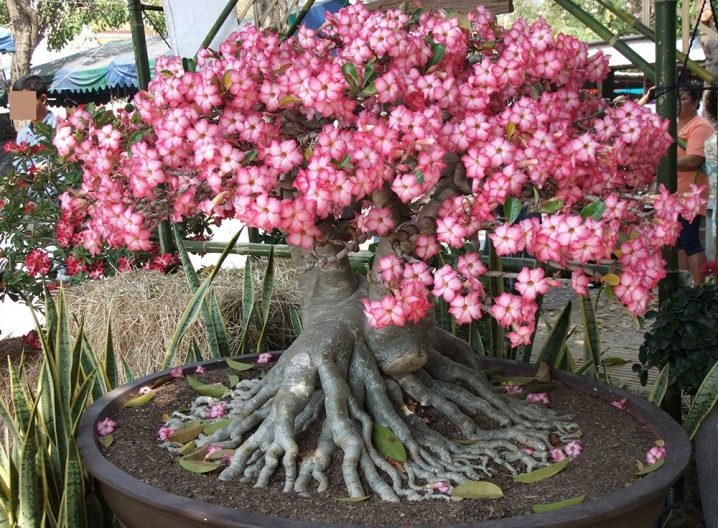
Succulent is very poisonous. The indigenous inhabitants of Africa used the juice of "Adenium" during a hunt or war, rubbing poison on arrowheads and spearheads. For the first time, biologists compiled a description of "Obesum" in the 18th century, at the same time the classification of species was determined. To date, 10 plant species have been identified, differing in size and shape of the stem, leaves, flowers.
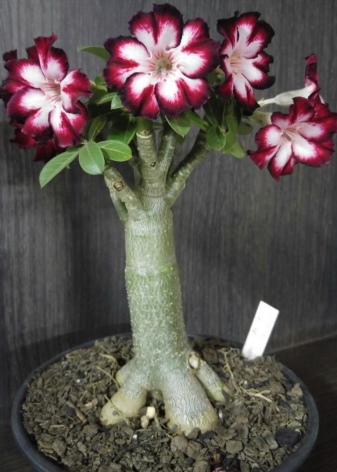
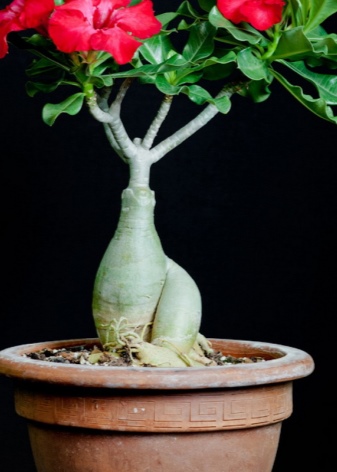
Obesum is the most widespread among flower growers. Because of the caudex, the flower resembles a bonsai, but is less demanding than a mini-tree. The height of a houseplant rarely exceeds 0.7 m, and the trunk, due to the formation, can take on an amazing appearance. The flower is responsive to leaving and reacts calmly to actions with its stem. Growers, forming a plant, can splic several trunks together, braid the shoots in braids, or cut them to create fantastic designs.


Diseases and pests
Observing the rules of care and maintenance, it is easy to get a healthy unique plant with unusual caudex shapes and beautiful flowers. Despite its toxicity, "Adenium" has not escaped various diseases and pests. The greatest danger to him is root decay. The reason for this is the heavy waterlogged soil, stagnant water in the flowerpot and cold air. To cope with this situation, you must:
- remove the flower from the ground;
- wash and dry the root system, removing damaged parts;
- plant a flower in a new succulent substrate.
Root mites can grow in light dry soil.In the fight against this pest, soil treatment before planting and spraying with Fitoverm or Aktar, if the plant has already been planted, will help. Small holes on the top of the leaf plate and the lower part of the leaf covered with cobwebs indicate that the "Desert Rose" is affected by a spider mite. It is difficult to deal with this pest in indoor conditions; poisonous substances are used to combat it.


Mealybug leaves behind a white coating and small black dots. The affected plant stops growing, and the shoots become lethargic. Having washed the leaves of the plant with soapy water and sprayed with a solution of alcohol or infusion of cyclamen, you can cope with the pest at the initial stage of the lesion. In an advanced case, the use of pest control agents such as "Actellik" will help. Fungal diseases in the "Desert Rose" occur due to mistakes in care:
- too wet soil;
- lack of heat;
- poor drainage.
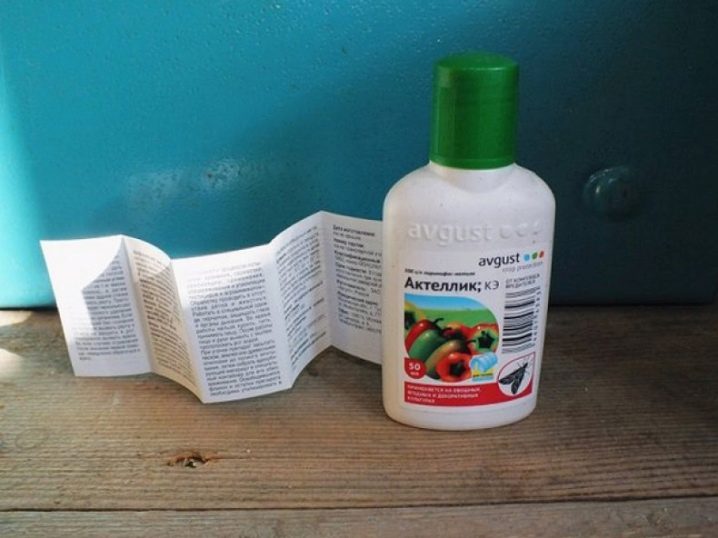
Soft branches, crumbling faded leaves are a sign of fungal diseases. The plant can be saved by transplanting "Impala Lily" into a pot with fresh, fungicide-treated, dry substrate. In the process of transplanting, the damaged parts of the flower are removed, the places of the cuts are dried and sprinkled with charcoal. Watering "Obesum" only after 3 days. The air temperature should not fall below 23 ° C in order to avoid a return of the disease.
For information on how to properly care for obese adenium, see the next video.
Adenium care
Home care for such a tropical flower is simple and does not require special skills. With the correct adherence to a number of recommendations, this exotic plant will turn into a real miracle, and will delight with its unusual appearance for many years.
Lighting
The plant loves a lot of light, in the summer it is recommended to expose it to fresh air under the direct rays of the sun so that it can be properly saturated with them and saturated with oxygen.
The maximum possible lighting is the key to full flowering and rapid growth, which means the beautiful appearance of this succulent.
In cold weather, the flower must be placed closer to the light, for example, it can be a window on the south side. It grows well in indoor winter gardens, but the air temperature must be at least +10 degrees, and additional light must be created using a special lamp.
Watering
The watering regime of the plant is the same as that of a regular cactus: first, the ground is completely soaked, and then it is dried. Do not allow the soil to dry out, otherwise it will stop the growth of the flower. In winter, watering is reduced as much as possible.
Important! Excessive soil moisture should not be allowed, otherwise it will negatively affect the root system and lead to decay, which means to the complete death of the plant.
Priming
Adenium prefers porous and loose soil, this should be taken into account when planting. It is good if the soil contains a small amount of charcoal. In addition, it should include:
- perlite;
- expanded clay, necessarily small;
- coke fiber;
- humus.
When preparing the soil, it should be borne in mind that it should not retain moisture for too long and be maximally saturated with the necessary elements.
This video describes what the soil for Adenium consists of, and the rules for watering.
Pot selection
Choosing a pot requires a little more rhizome so as not to squeeze the roots of the flower. The container must be necessarily wide and flat, and the volume at the top, exceed the bottom by 3-5 cm. First, a layer of expanded clay is poured onto the bottom, and then the plant is placed, and the soil is filled up.
Important! In a pot that is too large, there is a high likelihood of rotting of the root system, since an excessive volume of soil slows down the drying of the substrate.
Top dressing
To feed Adenium, you should choose organic and mineral fertilizers, which contain in equal proportions:
- nitrogen;
- potassium;
- phosphorus.
Soluble plant additives should be added at the beginning of the summer season.
Pruning
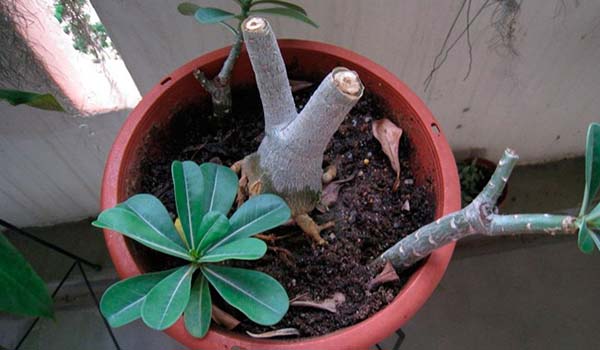
After about a year, it is recommended to prune the top of the adenium to allow the plant to branch out. During the period of active growth of the flower, it is necessary to cut off thin and weakly vital stems. After 1-1.5 months, new shoots will appear at the site of the cuts.
In mature shrubs, root pruning is necessary. This will give Obesum exoticism and special decorative effect.
It should be remembered that if you cut the main stem too low, many unnecessary shoots will appear, which can lead to improper development of the flower.
Description of Adenium obesum
As you can see in the photo, this is a small, beautifully flowering tree with a massive trunk. It grows slowly, but at the same time it can reach two meters in length and up to 100 cm in width. The stem is gray with a brown tint, it has an extension at the very base.
Its shape depends on the place of growth, it can be bushy, or woody. Leaves leathery to the touch, spiral-shaped, up to 15 cm long, greenish-gray.
Adenium is appreciated by flower growers not only for its unusual shape, but also for exotic flowers that are distinguished by their variety. They can be variegated, double and semi-double, pale and bright shades.

The evergreen shrub is highly resistant to drought and prefers tropical climates. In the warm season, it is covered with a large number of corymbose inflorescences with tubular flowers of red, white, burgundy or pale pink color.
Adenium arabicum and obesum what is the difference
The differences between Adenium Arabicum and Obesum lie in their flowering and caudex build-up. Arabicum grows faster, but it has a simple flowering. Obesum develops a little slower and blooms beautifully, with lush double flowers with various shades.
Obesum adeniums have gained particular popularity for their exotic appearance, good ability to adapt at home and unpretentious care.
If you follow all the recommendations of flower growers, then you can easily grow an unusual tree. It will not only fascinate with unusual flowers, but also cheer you up with its funny shape of the trunk. If you show your imagination, then you can easily create a real masterpiece from Adenium that will delight the eye for many years.
By watching this video, you will learn how the roots of a wonderful guest from Africa are formed
2> Reproduction
Propagated by the "Star of Sabinia" by sowing seeds and cuttings. You can buy seeds at any specialty store. There are no difficulties in sowing, even a novice grower will have no problems with this:
- soak the seeds in water or in a solution of a biostimulant, or you can do without soaking;
- disinfect the soil before sowing;
- spread the seeds over the surface of the moistened soil and cover the container with foil;
- put the container with seeds in a lighted place.
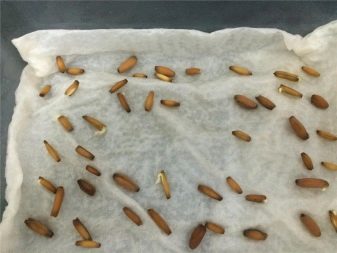
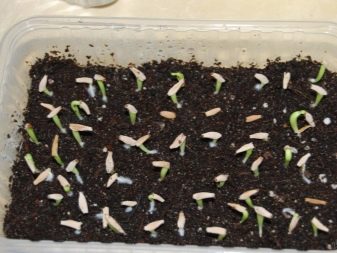
The first shoots will appear in about 5 days. Seedlings need warmth, light and moist air. The greenhouse should be periodically ventilated by opening the film. Sowing is best done in January - February, so that the formation of a succulent can begin by autumn. If it is possible to provide the necessary conditions, then sowing can be done all year round.
For propagation by cuttings, take the branches left after cutting. The place of the cut is dried within 24 hours, and then placed in a container with a small amount of water so that it slightly covers the bottom of the appendix to a height of no more than 1 cm.Or you can immediately plant the cutting in the ground without watering and cover with a glass to create a greenhouse effect. It will be possible to water in a week, moistening the soil around the seedling, but not pouring it under the root. Cutting has one drawback: with this method of propagation, the caudex may not form. To avoid the loss of decorativeness, they use the ability of the plant to easily grow together with others like them in places where the cuts are made.
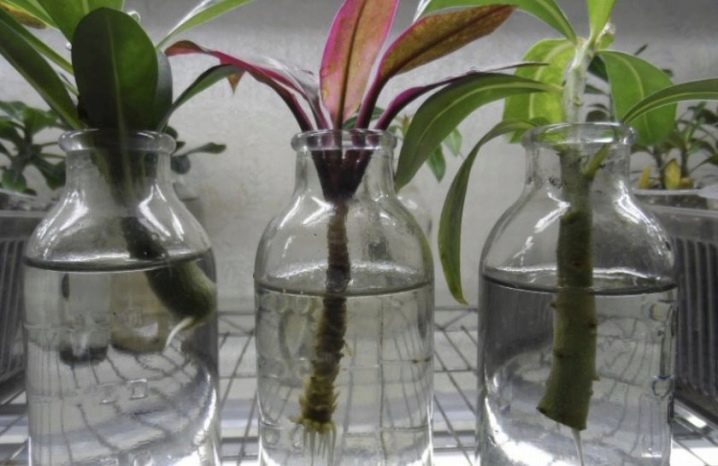
Conditions of detention
"Adenium obese" is an unpretentious plant that easily responds to compliance with the conditions of detention. It is better to take a succulent pot with a light, wide, round shape with a lot of drainage holes. A light pot will protect the soil from overheating and rotting of the root system. The diameter of the pot should be 2-3 times its depth. As part of the best substrate for "Obesum":
- coconut fibers, taking up half the volume;
- 3 pieces of leafy land;
- 1 part perlite;
- 1 part of expanded clay mixed with charcoal.

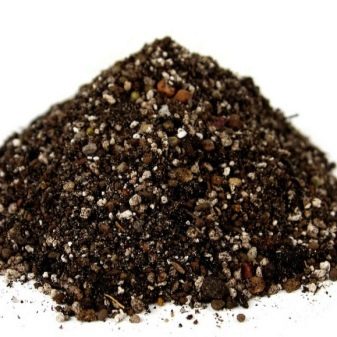
Loose neutral or slightly acidic soil must contain the necessary amount of fertilizers for the successful development of "Adenium". For the development of the "Rose of the Desert" needs bright sunlight, so "Obesum" is placed on the windowsills of the southern windows or on a balcony protected from drafts. The air temperature must be above 25 ° C.

How to care?
Proper care of "Obesum" at home will give you the opportunity to admire the beautiful flowering of "Impala Lily" for a long time. The main thing is to remember that the plant is poisonous, and all work with it must be carried out with protective gloves in order to exclude contact of the juice with the skin. Watering is the basis for flower care. "Desert Rose" easily withstands drought and poor soils, so the under-watering rule applies to the plant. Too moist soil, especially in combination with cold air, causes root rot and death of the flower. "Obesum" is watered when the soil is completely dry, abundantly wetting the earth ball, but not letting the water stagnate in the pot. During the growing season, before flowering, it is recommended to spray the flower with warm water. With a decrease in temperature, the need for water decreases, so in winter the flower is watered no more than 2 times a month.

With the resumption of growth, the flower requires additional nutrients. Top dressing with fertilizers containing potassium, nitrogen and phosphorus every month and a half will provide "Adenium" with everything necessary for growth and lush flowering.
The roots of "Obesum" grow very quickly, so the plant needs regular transplantation. Young seedlings require transplanting up to 3 times per season, seedlings under the age of 3 years are transplanted 2 times a year. For adult plants, dishes and soil are changed every spring, following a series of simple steps.
- Before planting, the soil is disinfected with hot steam.
- A layer of expanded clay, broken brick or large pebbles is placed on the bottom of the pot, the finished substrate is poured on top.
- The plant is removed from the ground, washed and dried the roots, along the way checking them for safety. Remove dead or damaged roots, cut out damaged areas.
- The treated plant is planted in a new flowerpot, sprinkling caudex with soil for stability.
- If the soil is wet, you don't need to water it right away.

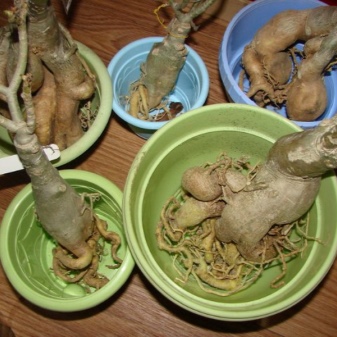
From the age of three months, seedlings begin to form a caudex and a crown. To do this, pinching the growth point, trimming excess branches and growing the shoots in the right places are used. Sprouts for grafting are taken from other plants or from the flower itself, when excess branches are cut. Grafting allows you to get a bush with colorful leaves and flowers.
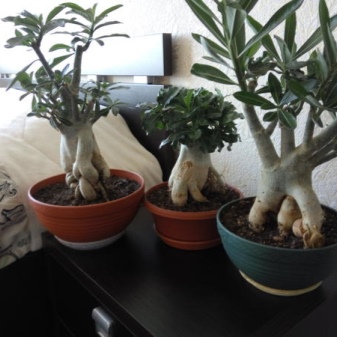

Obesum is formed not only by the crown, but also by the roots. Pinching of the central root is done to a month-old seedling at the first transplant: this will ensure the active growth of lateral roots. If you arrange them in a circle, then in the process of growth the flower will rise above the ground on several thick roots of an interesting shape. Grow "Adenium", forming a central tap or several lateral roots. Root pruning is carried out only on mature plants.
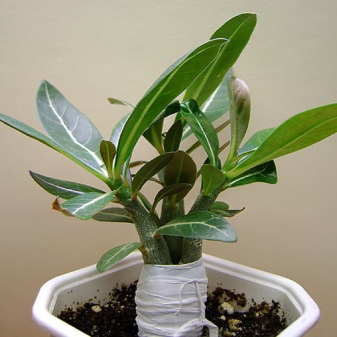
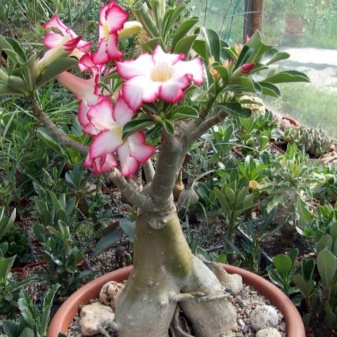
"Adenium" is a native of hot countries, therefore high air temperature and an abundance of sunlight are necessary conditions for the growth and development of a plant. But for good health, "Obesum" should be provided with the opportunity to hibernate when the flower's vital activity stops.A decrease in temperature in winter will give the succulent an opportunity to gain strength for a new flowering, the main thing is to prevent cooling below + 10 ° C.

Difference from "Arabicum"
The second most popular among amateurs is "Adenium Arabicum". Despite the great similarity of species, between "Obesum" and "Arabicum" there is a difference in appearance and in places of distribution. "Adenium obese" grows in deserts from Senegal to Saudi Arabia. A fleshy grayish-brown bottle-shaped trunk is crowned with numerous shoots, which in the spring-summer period are covered with flowers and leathery gray-green leaves. The plant is considered evergreen, but it has dormant periods when the plant stops growing and stops flowering.

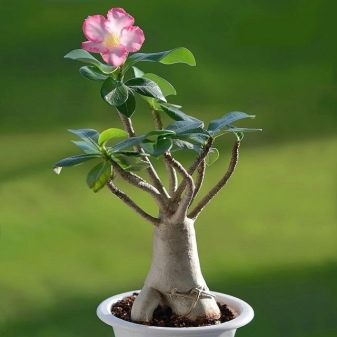
"Adenium Arabicum" also grows in the Arabian Peninsula, meeting in the deserts of Yemen and western Saudi Arabia. The plant has a low, thick caudex, pinkish with a purple tint or dark brown, clearly visible already at an early age. Saudi Arabicum preserves foliage all year round. Yemeni "Arabicum" has a pronounced dormant period when the plant completely sheds its leaves. The first time a succulent blooms in 3-4 years.

Types of Adenium obesum
In nature, there are many varieties of Adenium, but there are few cultivated and artificially bred species.
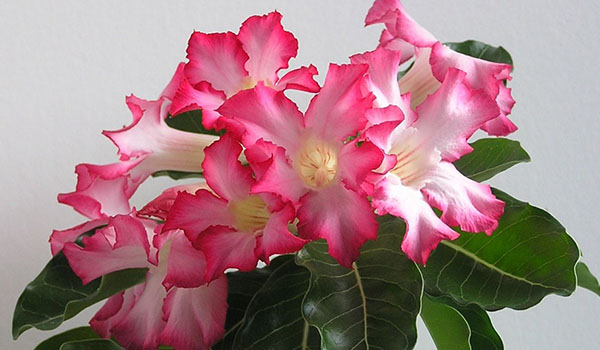
Obesum. The most popular home look. It blooms for a long time, and the color of the flowers can have different shades.
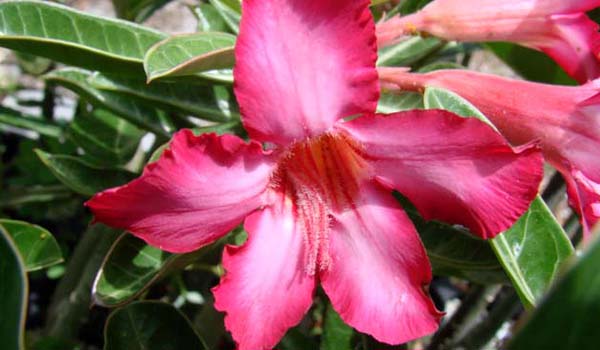
Somali. A fairly large tree with numerous small flowers of a pink or red hue.
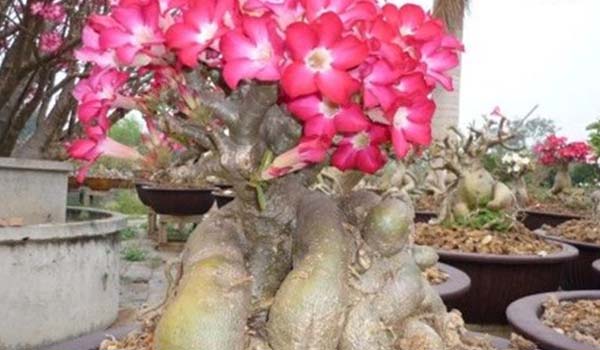
Socotransky. A dwarf species, with bright green leaves and small flowers of pale pink or bright red.
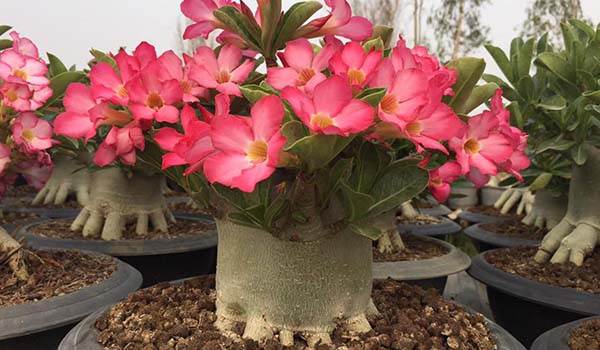
Arabic (arabicum). It is a small copy of a wild plant and blooms with bright pink flowers.
This video describes the views of Adenium.
2> Breeding methods
Reproduction of Adenium takes place in the usual ways, like most other plants.
Seeds
This breeding method is great for inexperienced florists. Seeds of an exotic plant can be purchased at any flower shop, germination is good, up to 95%. Before planting, the seeds must be treated with any growth stimulant for speedy growth. The planting material is wrapped in cloth, placed in a shallow container, biofertilizer is added and placed in a warm place for 2-3 hours.
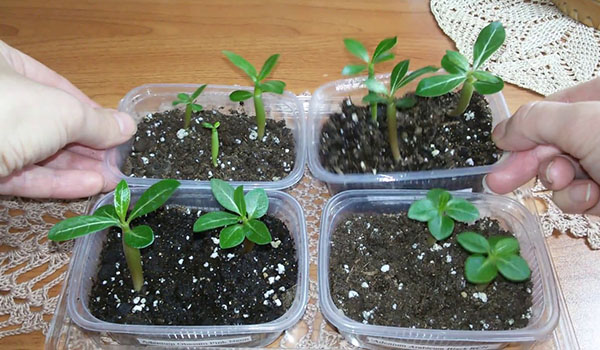
Growing adenium foggy from seeds allows for a thicker, more massive root. And also a decoratively compact crown, but this method does not give quick results.
Many experienced growers believe that it is not necessary to soak the seeds before planting. You can get good shoots even if you plant them directly into the ground.
Cuttings
This method of reproduction is more complicated and takes a lot of time, but it gives 100% result. For grafting, only the upper shoots of the flower are suitable, the length of which is at least 10 cm. The cut cuttings are dried and planted in a pre-prepared mixture of sand and charcoal.
To quickly form roots, you should follow simple rules: keep the temperature at least + 25 degrees and create sufficiently bright lighting.
The first roots will appear in about a month. The main advantage of such reproduction is that the Adenium begins to bloom earlier than the plant grown from seed. But there are also disadvantages - the formation of the thickening of the trunk itself is inhibited.
